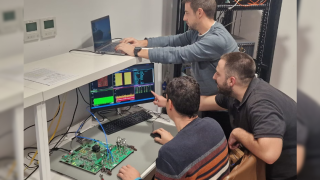The rollout of the next generation of mobile technology has started. “In South Korea they are installing 3,000 sites a month,” says Steven Wu (pictured), president of the consulting and service solution sales department at Huawei.
It’s a complex process, and Huawei is bringing all its skills – including artificial intelligence (AI) – to the process. AI can help a physical site become a digital site, can also manage the power consumption of each cell site, can improve operations and maintenance, can improve radio coverage, and can improve time to market, he says.
“We need a good professional service that enables the network to be monetised. Huawei has a pretty easy solution to bring 5G to reality. We work widely in business innovation,” says Wu.
It’s not just those South Korean cell sites he’s talking about. “We have signed more than 30 commercial contracts,” says Wu. Many of those haven’t started service yet, but the company is already beginning the preparation work.
We take those issues that Wu listed one by one. Site selection is, of course, key. “The site density for 5G will be more than 4G,” he notes. Wu smiles: “With our digital engineering solution we can reduce time to market by 30%.”
He notes – something that will be surprising to many – that the 4G network will still be integral to the service, for both voice and data. “4G will be crucial to the operators for a long time,” confirms Wu, “and we have implemented 400 4G networks globally.” So what’s the point of keeping 4G? Voice over LTE (VoLTE) will be used for the voice service even when it’s 5G, he explains. “It will last for a long time.”
With 4G co-exist with 5G, drive test will be hugely important. Huawei is working to make the drive test as efficient and effective as possible, he says. With optimisation, “we can improve performance two to four times”, he adds. “The 4G network will be a long-term foundation network for voice and data.”
Operators also need to think about power for all those cell sites, adds Wu.
So how can operator reduce power? “We can save at least 10%-15% energy per site by dynamically cutting off transmitters when we can,” he says. At the moment, cell sites consume power even when they’re not transmitting any data. Huawei wants to reduce consumption to zero when a site is inactive. “We have a target of zero bits, zero watts,” he smiles. “Using AI technology and big data, we can reach zero bits and zero watts,” he adds.
He points to a practical example. Think of a cell site that’s covering a high-speed railway line – and China has around 29,000km of high-speed lines, with trains travelling at 250-350km/h.
“Think of a high-speed train passing every 10 minutes,” says Wu. “Each one takes 30 seconds to pass the cell site. That means for nine and a half minutes it’s shut down.” Do the maths: if you can reduce power to zero watts for that time, you cut consumption to just 5%.
Furthermore, “AI can be used for radio propagation modelling – the Rayce model”, he adds. “We can improve planning accuracy 10%-20%, compared with industry leaders.”
The new 5G base stations will use massive MIMO – multiple input, multiple output – a technique that improves data speeds but adds to the complexity “by 100 times”, he says. More AI can help here.
Current networks run 3G and 4G services in parallel – some phones don’t yet have 4G and even many 4G phones revert to 3G for voice calls (VoLTE is a way of moving voice to 4G, while improving quality and making the service more efficient). And many operators still have a residual 2G service – inefficient in terms of bandwidth but necessary for some 2G-only visitors and a few early smart meters and the like. “We’ll be able to run the different networks,” says Wu.
“Huawei has developed a new cloud-based platform. We use big data, with AI, and root cause analysis to identify faults. The aim is zero intervention, zero outage, and zero risk. We reduce the fault resolution time from six hours to three hours.”
Digital transformation is becoming very important, he notes, “but it is not an easy journey”. There are three key points: first culture. “People are afraid of change – you have to change minds and accept new concepts. You need a change of mindset for the whole company.”
And digital transformation depends on strong leadership, he adds. “We need a clear and firm strategy and strong leadership.”
Finally, the organisation and process. “Traditional companies have a traditional way of working. We need to reboot the company process.” That needs the introduction of new skills into the operation.





